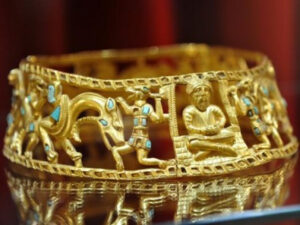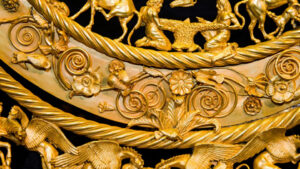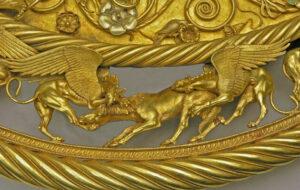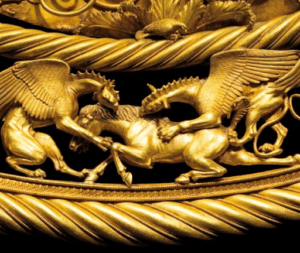
The Allard Pearson Museum has transferred to Ukraine artifacts from four Crimean museums that were presented at an exhibition in Amsterdam, the National Museum of History of Ukraine reports.
“After almost 10 years of litigation, artifacts from four Crimean museums that were presented at the exhibition “Crimea: Gold and Secrets of the Black Sea” in Amsterdam have returned to Ukraine. The Allard Pearson Museum transferred them to the National Museum of History of Ukraine. It is there that they will be stored until the de-occupation of Crimea,” the museum’s website said on Monday.
The press service reminds that the exhibition of artifacts was held from February to August 2014 at the Allard Pearson Museum. It featured items from the collections of the National Museum of History of Ukraine and four museums in Crimea: National Reserve “Chersonesos Tavriya” (Sevastopol), Central Museum of Tavrida (Simferopol), Bakhchisaray Historical and Cultural Reserve and Kerch Historical and Archaeological Reserve.
“In February 2014, Russia began the occupation of Crimea. Objects from the collection of the National Museum of History of Ukraine returned to Kyiv after the exhibition. At the same time, it became impossible to return valuables from Crimean museums to the territory not controlled by the Ukrainian authorities. However, the Crimean museums, which are de facto controlled by the Russian authorities, insisted on doing just that. A trial has begun in the Netherlands,” the statement said.
In December 2016, a court in Amsterdam ruled to transfer the artifacts to Ukraine in accordance with the law on heritage. In addition, the Court of Appeal decided to satisfy the claim for the transfer of Crimean artifacts to Ukraine, but on the basis of the Law of Ukraine “On Museums” and the order of the Ministry of Culture of Ukraine of March 2014, according to which the Minister of Culture has the authority to decide on the transfer of artifacts for safe keeping if there is a risk of their loss/damage/destruction.
At the same time, the Crimean museums filed a cassation appeal with the Supreme Court of the Netherlands to overturn the decision of the Court of Appeal, but on June 9, 2023, the court dismissed the museums’ cassation appeal and upheld the appeal decision.
According to the decision of the Supreme Court of the Netherlands, Ukraine had to pay the Allard Pearson Museum EUR111,689 with interest for the entire period of storage of the Crimean museums’ collections.
“After fulfilling the obligations undertaken by the National Museum of History of Ukraine and the Ministry of Culture and Information Policy of Ukraine, the Allard Pearson Museum refused the payment determined by the court in its favor,” the statement said.
Currently, experts are examining the condition of 565 artifacts, including ancient sculptures, Scythian and Sarmatian jewelry, and Chinese lacquer boxes that are 2,000 years old.
According to the State Customs Service of Ukraine, the Kyiv customs office has begun customs clearance of the Scythian Gold.
“Right now, a truck with 2,694 kg of cultural property known under the common name ‘Scythian Gold’ has entered the territory of the Kyiv-Pechersk Lavra, where Kyiv customs officers will identify the treasures in the Treasury of the National Museum of Ukraine,” reads a message posted on the telegram channel.

Acting Minister of Culture and Information Policy Rostislav Karandeyev announced the return to Ukraine in the near future of the collection of “Scythian gold”, which was exhibited in a museum in the Netherlands, according to the press service of the ministry.
“The Ministry together with partners from the Netherlands is carrying out a number of activities aimed at the earliest possible return of the collection of artifacts to Ukraine,” – said Karandeev.
As reported, the exhibition “Crimea. Golden Island in the Black Sea”, representing the collection of Scythian gold jewelry, was formed at the Allard Pearson Museum from the collections of five museums, one of which is located in Kiev, four – in Crimea. After the occupation of Crimea by the Russian Federation, which occurred after the opening of the exhibition, the question arose as to whom to return the collection – 565 museum objects with a total insured value of EUR10 million.
The Russian Federation claimed its rights to part of the collection belonging to Crimean museums after the occupation. Ukraine, in turn, stated that the exhibits cannot be returned to the occupied territory, which is temporarily not under Ukrainian control, and must be transferred directly to the state of Ukraine.
In December 2016, the District Administrative Court of Amsterdam recognized Ukraine’s rights to the collection and ordered its transfer to Kiev. In October 2021, the Amsterdam Court of Appeal confirmed the decision of the court of first instance. After that, in January 2022, the “Crimean Museums” filed a cassation against the decision of the Court of Appeal.
On June 9, the Supreme Court of the Netherlands upheld the decision of the previous instance in the case on the fate of the “Scythian gold” and ruled to hand it over to Ukraine.

The Supreme Court of the Netherlands upheld the decision of the previous court in the case on the fate of the “Scythian gold” from the collection of museums of the Autonomous Republic of Crimea and decided to transfer it to Ukraine, follows from the message on the website of the court.
“In October 2021, the Court of Appeal ruled that the collection should be transferred to Ukraine. This decision remains in force. That’s what the Supreme Court ruled today,” the message says.
As reported, the exhibition “Crimea. Golden Island in the Black Sea”, representing the collection of Scythian gold jewelry, was formed in the Allard Pearson Museum from the collections of five museums, one of which is located in Kiev, four – in Crimea. After the occupation of Crimea by the Russian Federation, which occurred after the opening of the exhibition, the question arose as to whom to return the collection – 565 museum items with a total insured value of EUR 10 million.
After the occupation, the Russian Federation claimed its rights to the part of the collection belonging to the Crimean museums. Ukraine, in turn, said that the exhibits cannot be returned to the occupied territory, which is temporarily not under Ukrainian control, and must be transferred directly to the state of Ukraine.
In December 2016, the District Administrative Court of Amsterdam recognized Ukraine’s rights to the collection and ordered it transferred to Kiev. In October 2021, the Court of Appeal of Amsterdam confirmed the decision of the court of first instance. After that, in January 2022, “Crimean museums” filed a cassation against the decision of the Court of Appeal.

The Court of Appeal in Amsterdam ruled to return the “Scythian gold” to Ukraine, first we will return the “Scythian gold,” and then the Crimea,” the head of state Volodymyr Zelensky said.
“The long-awaited victory in the Amsterdam Court of Appeal! ‘Scythian gold’ returns to Ukraine. Grateful to the court for a fair decision, and to the Ministry of Justice, the Ministry of Foreign Affairs and the Ministry of Culture and Information Policy of Ukraine for the result. We always regain what is ours. After the ‘Scythian gold,’ we will return Crimea,” Zelensky said on Twitter on Tuesday.
The Amsterdam Court of Appeal ruled on an appeal against a ruling by the Amsterdam District Court in December 2016 that the Allard Pierson Museum was to transfer the Crimean treasures to the Ukrainian state.
This is a collection of artifacts from four Crimean museums.